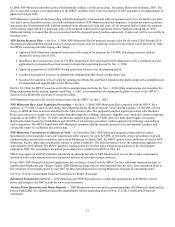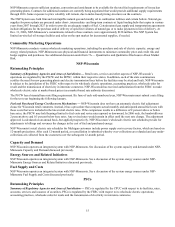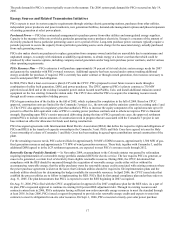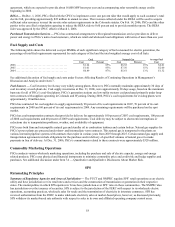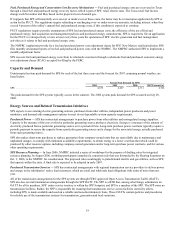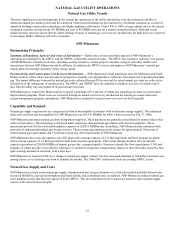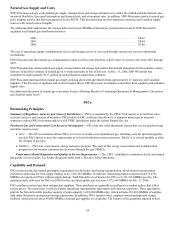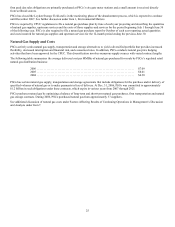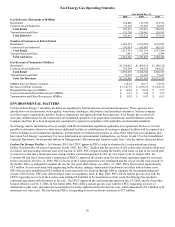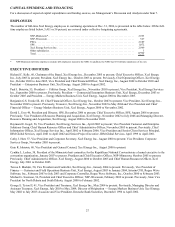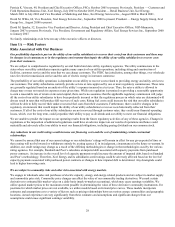Xcel Energy 2006 Annual Report Download - page 29
Download and view the complete annual report
Please find page 29 of the 2006 Xcel Energy annual report below. You can navigate through the pages in the report by either clicking on the pages listed below, or by using the keyword search tool below to find specific information within the annual report.
19
Fuel, Purchased Energy and Conservation Cost Recovery Mechanisms — Fuel and purchased energy costs are recovered in Texas
through a fixed fuel and purchased energy recovery factor, which is part of SPS’ retail electric rates. The Texas retail fuel factors
change each November and May based on the projected cost of natural gas.
If it appears that SPS will materially over-recover or under-recover these costs, the factor may be revised upon application by SPS or
action by the PUCT. The regulations require refunding or surcharging over- or under-recovery amounts, including interest, when they
exceed 4 percent of the utility’s annual fuel and purchased energy costs, if this condition is expected to continue.
PUCT regulations require periodic examination of SPS fuel and purchased energy costs, the efficiency of the use of fuel and
purchased energy, fuel acquisition and management policies and purchased energy commitments. SPS is required to file an application
for the PUCT to retrospectively review at least every three years the operations of SPS’ electric generation and fuel management
activities as it relates to fuel and purchased energy costs.
The NMPRC regulations provide for a fuel and purchased power cost adjustment clause for SPS’ New Mexico retail jurisdiction. SPS
files monthly and annual reports of its fuel and purchased power costs with the NMPRC. The NMPRC authorized SPS to implement a
monthly adjustment factor.
SPS recovers fuel and purchased energy costs from its wholesale customers through a wholesale fuel and purchased economic energy
cost adjustment clause (FCAC) accepted for filing by the FERC.
Capacity and Demand
Uninterrupted system peak demand for SPS for each of the last three years and the forecast for 2007, assuming normal weather, are
listed below.
System Peak Demand (in MW)
2004 2005 2006 2007 Forecast (a)
SPS ................................................. 4,679 4,667 4,711 4,722
The peak demand for the SPS system typically occurs in the summer. The 2006 system peak demand for SPS occurred on July 20,
2006.
Energy Sources and Related Transmission Initiatives
SPS expects to use existing electric generating stations, purchases from other utilities, independent power producers and power
marketers, and demand-side management options to meet its net dependable system capacity requirements.
Purchased Power — SPS has contractual arrangements to purchase power from other utilities and nonregulated energy suppliers.
Capacity is the measure of the rate at which a particular generating source produces electricity. Energy is a measure of the amount of
electricity produced from a particular generating source over a period of time. Long-term purchase power contracts typically require a
periodic payment to secure the capacity from a particular generating source and a charge for the associated energy actually purchased
from such generating source.
SPS also makes short-term purchases to replace generation from company-owned units that are unavailable due to maintenance and
unplanned outages, to comply with minimum availability requirements, to obtain energy at a lower cost than that which could be
produced by other resource options, including company-owned generation and/or long-term purchase power contracts, and for various
other operating requirements.
SPS Resource Planning — In June 2006, NMPRC initiated a series of workshops for the purpose of drafting rules for integrated
resource planning. In August 2006, workshop participants completed a consensus rule that was forwarded by the Hearing Examiner on
Oct. 3, 2006, to the NMPRC for consideration. The proposed rules would apply to jurisdictional electric and gas utilities, such as SPS,
that operate within the state. A final rule is expected to be adopted in early 2007.
Purchased Transmission Services — SPS has contractual arrangements with regional transmission service providers to deliver power
and energy to the subsidiaries’ native load customers, which are retail and wholesale load obligations with terms of more than one
year.
All of the transmission arrangements for the SPS system are through FERC approved Open Access Transmission Tariffs (OATT).
SPS also has several transmission arrangements through the SPP OATT. The SPP is a RTO that, among other things, administers an
OATT for all its members. SPS’ entire service territory is within the SPP footprint, and SPS is a member of the SPP. The SPP owns no
transmission facilities. Rather, the SPP is responsible for ensuring that transmission service across facilities owned by others,
including SPS, is made available and used on a reliable and non-discriminatory basis. These OATTs contain policies and procedures
for reliable use of the transmission systems for transmission, generation and load variations.





